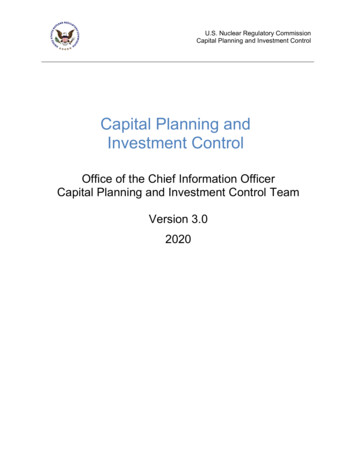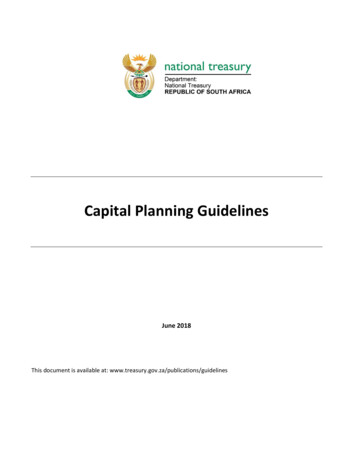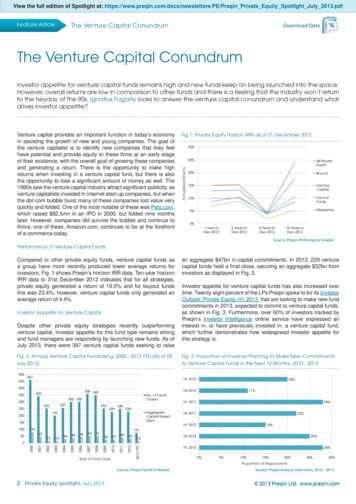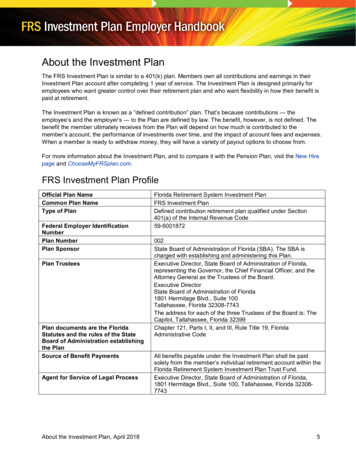
Transcription
U.S. Nuclear Regulatory CommissionCapital Planning and Investment ControlCapital Planning andInvestment ControlOffice of the Chief Information OfficerCapital Planning and Investment Control TeamVersion 3.02020
U.S. Nuclear Regulatory CommissionCapital Planning and Investment ControlRevision HistoryDATE12/28/2015VERSION1.0SUMMARY OF CHANGESUpdated CPIC) processes to include newrequirements from FITARA) and to reflectinternal organizational changes. Thisdocument supersedes previous CPICprocess documentation and supplementsthe “Capital Planning and InvestmentControl Policy and Overview” posted on theNRC IT Policy Archive at nrc.gov.AUTHORVickie Smith,OCIO/PMPD/IPMBApproved byDarren Ash, CIOADAMS Accession No. ML15260A90412/31/20172.0Revised the Capital Planning andInvestment Control (CPIC) process toinclude updates to information technology(IT) governance, a new Select phase,additional Chief Information Officer (CIO)roles and responsibilities in incrementaldevelopment, various updates from thebudget year 2019 IT budget/capital planningguidance, modifications to the CIOevaluation process, updates to theappendix, and other minor updates.Leah Kube,OCIO/GEMS/PIMBApproved byDave Nelson, CIOADAMS Accession No. ML17349A08312/26/20182.1Updated CPIC process to include edits oftypographical errors, updates to the Selectprocess, updates to the evaluate process,and other minor updates.Leah Kube,OCIO/GEMS/PIMBApproved byDave Nelson, CIOADAMS Accession No. ML18360A46112/31/201912/8/20202.22.3Updated CPIC process to include edits oftypographical errors and updates to theSelect process, decoupled the MonthlyUpdates and CIO Evaluations processes,and added standard investments to theMonthly Updates and CIO Evaluationprocesses.Leah KubeOCIO/GEMS/IPSMBUpdated the following processes andprocess areas: Preselect, Execution YearChanges. Made formatting andtypographical updates.Lance Breeden/SandraValenciaOCIO/GEMS/APIBApproved byDave Nelson, CIOApproved byDave Nelson, CIO
U.S. Nuclear Regulatory CommissionCapital Planning and Investment ControlTable of ContentsBackground . 1Purpose. 2The NRC’s Information Technology/Informaton Management Governance . 2The NRC’s Information Technology Investment Review Boards . 2The Information Technology/Information Management Portfolio Executive Council . 2The Information Technology/Information Management Board . 3Capital Planning and Investment Control . 5Select Process: Screen, Compare, and Choose . 6Preselect and Select Phases . 6Key Preselect and Select Phase Concepts . 7Roles and Responsibilities . 9Process Mechanisms . 11Preselect and Select Phase Artifacts . 13Process Diagram and Notation Summary . 14Preselect Phase Process Overview . 15Select Phase Process Overview . 19Business Case Development and Portfolio Selection Processes . 20Prioritization and Funding Processes . 24Reselection and Deselection Processes . 28Control Process versus Evaluate Process . 30Control Process: Monitor, Inform, and Correct . 31Major IT Business Case Submissions . 32Major IT Investment and Standard Investment Monthly Reviews . 34Major IT Investment and Standard Investment Chief Information Officer Evaluations . 36Quarterly Investment and Portfolio Reviews . 37Major IT Investment Control Reviews . 38CIO TouchPoints . 40Evaluate Process: Learn, Recommend, and Adjust . 40Postimplementation Reviews . 41Operational Analysis . 43Appendix A: The U.S. Nuclear Regulatory Commission’s Information Technology PortfolioStructure . A-1iii
U.S. Nuclear Regulatory CommissionCapital Planning and Investment ControlAppendix B: Information Technology Budget Certification and Approval . B-1Appendix C: Related Definitions . C-1Appendix D: Glossary of Figures and Tables . D-1Figures . D-1Tables. D-1iv
U.S. Nuclear Regulatory CommissionCapital Planning and Investment ControlBackgroundCapital Planning and Investment Control (CPIC) for information technology (IT) investmentsrefers to “a decision making process that ensures IT investments integrate strategic planning,budgeting, procurement, and management of IT in support of agency missions and businessneeds.” 1 The Clinger-Cohen Act of 1996 (CCA) requires Federal agencies to use disciplinedCPIC processes to acquire, use, maintain, and dispose of IT assets. Specifically, CCAmandates that an agency’s CPIC processes (1) provide for the selection, control, and evaluationof agency IT investments, (2) integrate with the processes for budget, financial, andprogrammatic decision making, (3) include minimum criteria for considering whether toundertake an IT investment, (4) identify IT investments that would result in shared benefits orcosts for other Federal agencies or State or local governments, (5) provide the means foridentifying quantifiable measurements for IT investment net benefits and risks, and (6) providethe means for senior management to obtain timely information on an investment’s progress. Tomeet these requirements, CPIC relies on three distinct, yet interdependent, sets of processes—Select, Control, and Evaluate.More recently, the Federal Information Technology Acquisition Reform Act (FITARA), enactedon December 19, 2014, established additional requirements. The Office of Management andBudget (OMB) issued guidance on implementing FITARA in Memorandum M-15-14,“Management and Oversight of Federal Information Technology,” dated June 10, 2015. FITARAbuilds on CCA by empowering Federal Chief Information Officers (CIOs) with increasedoversight for (1) budget planning, (2) governance structures, (3) portfolio risk management,(4) hiring practices within the IT offices, (5) data center consolidation planning and execution,and (6) reporting of progress and metrics to OMB. To build on and strengthen the CPICrequirements of CCA, FITARA establishes the Common Baseline for IT Management, whichdefines the roles and responsibilities of the CIO and other senior agency officials while ensuringthat the CIO retains accountability.To further assist agencies with meeting the requirements in CCA and FITARA, OMB issues itsannual IT Budget—Capital Planning Guidance as part of OMB Circular A-11, “Preparation,Submission, and Execution of the Budget,” issued July 2016, and maintains its supplement, the“Capital Programming Guide,” 2 to assist agencies with the implementation of CPIC processes.OMB Circular A-130, “Managing Federal Information as a Strategic Resource,” updatedJuly 27, 2016, provides additional guidance. OMB updates these circulars based on current,relevant statutes and Executive orders. CCA, FITARA, and associated OMB guidance serve asthe basis for CPIC policy, processes, and procedures at the U.S. Nuclear RegulatoryCommission (NRC).12The Office of Management and Budget defined the CPIC process in the “Integrated Data CollectionCommon Definitions” (see Volume 40 of the United States Code, Section 11302, for statutory requirementsand the Clinger-Cohen Act of 1996).The Capital Programming Guide can be found online 018/06/capital programming guide.pdf.1
U.S. Nuclear Regulatory CommissionCapital Planning and Investment ControlThe NRC’s CPIC policy, set forth in “Capital Planning and Investment Control Policy andOverview,” issued November 2020, is available on the NRC’s Web site at the NRC IT PolicyArchive Web page.PurposeThis document describes the NRC’s CPIC processes and explains how they support the NRC’sIT/information management (IM) governance. The descriptions of the NRC’s CPIC processesinclude the flow of inputs and outputs among the three distinct, yet interdependent, sets of CPICprocesses—Select, Control, and Evaluate. Toward that end, this document supplements the“Capital Planning and Investment Control Policy and Overview” by describing associated tools,techniques, and artifacts. Individual step-by-step procedures used to implement the processesare working documents developed and maintained by the Capital Planners in the Office of theChief Information Officer (OCIO).The NRC’s Information Technology/Information ManagementGovernanceThe NRC’s CPIC processes are critical to the management and oversight of the agency’s IT/IMresources because they implement the means for providing quality information andrecommendations to executive decisionmakers on IT investments for inclusion in the agency’sIT portfolio. IT investment management encompasses the NRC’s CPIC and IT budgetprocesses and is part of the agency’s integrated IT/IM governance framework. The NRC’s CPICprocesses support the CIO’s involvement in relevant governance boards and ensures that ITinvestments integrate and adhere to the framework’s other disciplines: (1) strategic planningand enterprise architecture (EA), (2) project management methodology (PMM), and(3) information and records management quality principles.The NRC’s CPIC processes also ensure that IT investments are reviewed for compliance withinternal cybersecurity standards set forth by the NRC’s Information Security Directorate in OCIOand with external cybersecurity standards mandated by the National Institute of Standards andTechnology and U.S. Department of Homeland Security throughout their life cycle.The NRC’s Information Technology Investment Review BoardsThe NRC uses various investment review boards to ensure that IT investments are reviewed atthe appropriate levels of the organization. The review boards encompass strategic businessplanning (which occurs at the executive level), program-level systems planning (which occursacross program offices), and technical architecture review (which occurs within OCIO). Thesetwo review boards include the IT/IM Portfolio Executive Council (IPEC) and the IT/IM Board(ITB).The Information Technology/Information Management Portfolio Executive CouncilThe CIO serves as one of the co-chairs on the IPEC, along with the Chief Financial Officer(CFO). The IPEC is an executive-level IT governance body established to determine the NRC’sstrategic direction for IT/IM and to manage the agency’s IT portfolio by setting current fiscalyear (FY) priorities and determining the funding of IT investments that effectively integrate intothe IT portfolio, as required by CCA, OMB Circular A-130, the Federal Information Security2
U.S. Nuclear Regulatory CommissionCapital Planning and Investment ControlManagement Act of 2002, and other Government requirements. This executive-level ITgovernance body has established roles, responsibilities, and processes consistent with thoserequired by FITARA. In addition to the IPEC co-chairs, voting members include the ChiefAcquisition Officer, Chief Human Capital Officer, and Chief Information Security Officer(collectively referred to as the CXOs); directors of the major program offices; and a RegionalAdministrator to represent all NRC regional offices. The directors of the major program officesalso serve as business line leads in budget formulation and execution and functional/businesssponsors of IT investments. In these roles, IPEC members provide insight into organizationalfunding needs and describe impacts on the mission if the required funding is not available. Asdirectors of major programs and as CXOs, IPEC members can provide valuable input andadvice on the many aspects of the NRC’s mission and business needs. Collaboratively, IPECmembers provide an enterprise perspective on what is in the best interest of the agency and itsmission. The IPEC has the following responsibilities: Decide IT/IM direction, values, information security activities, and the agency’s risktolerance for IT activities to achieve strategic program objectives. Approve major investments that will effectively integrate into the IT portfolio. Ensure that the agency’s capital plan supports the NRC’s priorities. Review the IT portfolio in the year of execution to address current FY priorities. Oversee the execution of the portfolio by reviewing portfolio health on a quarterly basisagainst established direction, values, and risk tolerance. Communicate IPEC discussion and decisions to other NRC boards and committees.The Information Technology/Information Management BoardThe CIO established the ITB as a management-level review board to review and recommendchanges to the agency’s IT portfolio based on the NRC’s mission and business needs. Themission of the ITB is to align IT investments and technology standards with the NRC’s strategicplan and architecture portfolio; provide resource, investment, and priority recommendations tothe IPEC; and ensure that IT investments are made in accordance with the agency’s directionsset by the IPEC. The ITB reviews new proposals and current IT investments to ensure thefollowing: alignment with IPEC priorities, the agency’s strategic direction, and budgetability to integrate into the NRC’s IT architectureconformance with technology standardsidentification of potential risks to the NRC environmentThe ITB leverages the expertise of subject matter experts (SMEs) for technical reviews. TheNRC’s CPIC processes and team also support and facilitate ITB reviews. The Capital Planners3
U.S. Nuclear Regulatory CommissionCapital Planning and Investment Controlwork closely with the Integrated Program/Project Teams (IPTs) of existing investments toexecute Control and Evaluate processes that inform ITB reviews. ITB reviews can result inminor corrective actions or in recommendations to the IPEC for matters warranting an executivedecision.To support ITB reviews of new proposals, the Capital Planners facilitate SME reviews, thePreselect process, and the Select process, based on input from office-level stakeholders. TheCapital Planners will ensure that proper facilitation occurs throughout the entire IT governanceprocess and that the most viable solution to meet the business need is considered for inclusionin the NRC’s IT portfolio. As the secretariat of both the IPEC and the ITB, the Capital Plannersfacilitate the meetings of both boards and act as a channel for communicating information,recommendations, and decisions between boards and among stakeholders.4
U.S. Nuclear Regulatory CommissionCapital Planning and Investment ControlCapital Planning and Investment ControlThe NRC recognizes that IT investment management is dynamic. As such, IT investments areselected and continuously monitored and evaluated to ensure that each IT investment in theNRC IT portfolio effectively and efficiently supports the agency’s mission and strategic goals.The NRC CPIC is designed to facilitate sound IT governance and the maturation of the agency’sIT investment management. The NRC’s CPIC model in Figure 1 relies on three distinct, yetinterdependent, sets of processes—Select, Control, and Evaluate.All three are applied concurrently to an IT investment once it becomes part of the NRC ITportfolio. After the IT investment’s initial funding in the Select process, it goes through theControl and Evaluate processes for review and reselection until it is determined that theinvestment has come to the end of its life. Upon this determination, the investment isdecommissioned and removed from the portfolio.Figure 1: Flow of data among CPIC processes.5
U.S. Nuclear Regulatory CommissionCapital Planning and Investment ControlSelect Process: Screen, Compare, and ChoosePreselect and Select PhasesThe purpose of the Preselect and Select phases of the NRC’s IT investment life cycle is toidentify and prioritize requests for new or enhanced IT capabilities that best support the NRC’smission and needs at an acceptable level of risk and cost. Throughout the activitiesencompassed by these phases, the key objectives include the following: identifying and evaluating the efficacy of proposed IT investments relative to theagency’s mission and its strategic plans and priorities assessing the risks and returns of each proposed new or enhanced IT capability beforecommitting funds validating the proposed investment’s alignment with the agency’s EA selecting those IT investments that will best support the agency’s mission needsFigure 2 illustrates how the Preselect and Select phases integrate with a wide range oforganizational functions and processes designed to ensure that the agency leverages its ITfunding as effectively as possible.6
U.S. Nuclear Regulatory CommissionCapital Planning and Investment ControlFigure 2: Preselect and Select phase process integration summary.During the Preselect and Select phases, current and potential IT capabilities are evaluated froma business and technical perspective to validate their efficacy and cost relative to potentialalternatives. This evaluation represents a critical pillar in conjunction with the agency’s Controland Evaluate phase activities, which support the continuous evolution and optimization of theagency’s IT portfolio.Key Preselect and Select ConceptsUnderstanding and participating in the agency’s Preselect and Select processes requireconsideration of several important concepts, including the following: drivers for proposed additions, enhancements, or retirements to the IT portfoliophase outcomes, including selection, reselection, and deselection of IT capabilitiesportfolio selection versus funding prioritization7
U.S. Nuclear Regulatory CommissionCapital Planning and Investment ControlDrivers for Proposed Additions, Enhancements, or Retirements to the IT PortfolioProposals for new or enhanced capabilities, as well as retirement of existing capabilities, aredriven by several internal and external factors, including the following: changes in the agency’s broader mission and support objectives evolving business and technical strategies changes in the agency’s required mission capabilities or shifts in priorities changes in the agency’s statutory and regulatory requirements new or updated Federal mandates trends in the nuclear materials industry evolution of vendor technologies and technical approaches that enable cost reductions,performance improvements, or new opportunities for innovation sunsetting of vendor support for legacy systems or solutionsThese factors create a continual requirement for assessment, review, and selection of currentand potential IT capabilities, as well as ongoing analysis of new technologies that may increasethe efficiency or effectiveness of the agency.Phase Outcomes: Selection, Reselection, and Deselection of IT Capabilities and EnhancementsThe Select phase results in three primary outcomes for an existing or proposed IT capability orenhancement:(1)Selection is the approval or disapproval of the addition of a new IT capability orenhancement to an existing capability.(2)Reselection is the approval or disapproval for the continued investment in and operationof an existing IT capability or ongoing enhancement, which may include one or moreadditional proposals for desired enhancements to fully realize the benefits of an ITcapability.(3)Deselection is the cancellation or decommissioning of a current capability or ongoingenhancement.Based on the outcome for a given IT capability or enhancement, the agency’s IT portfolio ismodified to reflect the decision, and funding is adjusted when appropriate.8
U.S. Nuclear Regulatory CommissionCapital Planning and Investment ControlPortfolio Selection versus Funding PrioritizationSelection or reselection of an IT capability or enhancement represents only an initial step in thebroader Select phase. The agency’s IT portfolio and its respective funding requirementsgenerally exceed the funding available; therefore, the agency leverages a prioritization processthat facilitates the ranking of the NRC’s investments within its IT portfolio. This prioritization viewof the IT portfolio enables agency leadership to continuously align the NRC’s ongoing ITcapabilities with the agency’s priorities.Roles and ResponsibilitiesTo function effectively, the Preselect and Select phases require a multidisciplinary team offunctional roles that reside across the agency’s mission and corporate support organizations.Table 1 summarizes the primary functional roles associated with the agency’s Preselect andSelect phase processes.Table 1: Primary Functional Roles of Multidisciplinary Team.ROLEAgency ITBudget LeadRESPONSIBILITY Supports the assignment and adjustment of funding to selected ITcapabilities and enhancements within the IT budget consistent with theagency’s budget processes and CIO decisions.BusinessSponsor Serves as manager or executive leader to advocate for, and to authorize,proposed IT capabilities or enhancements for one or more organizationalcomponents. For enterprise technologies, may be the CIO.BusinessStakeholder Uses agency IT capabilities to execute mission or corporate supportfunctions and processes. Identifies current or potential needs, issues, and opportunities that maybe addressed through the introduction of new IT capabilities or changesto existing capabilities. Is directly or indirectly impacted if a proposed IT investment is acceptedand implemented.ServiceOwner Helps evaluate whether the proposed IT capability or enhancement wouldsupport mission objectives without placing undue burden on the NRCstaff in the completion of its related tasks or whether it would likely resultin the expected benefits.CapitalPlanner Supports and provides oversight over the end-to-end IT investmentlife-cycle phases, including selection, control, and evaluation of currentand proposed IT capabilities or enhancements. Maintains the IT portfolio to reflect the current and planned ITinvestments, systems, and services and their associated activities. Facilitates external reporting to OMB as required by Federal mandate.9
U.S. Nuclear Regulatory CommissionCapital Planning and Investment ControlROLECIORESPONSIBILITY Works alongside agency leadership to define the strategic priorities for ITand to formalize assumptions about the EA and the availability offinancial resources. Serves as the primary approval authority on Select decisions and isaccountable for the IT portfolio.ContractSpecialist Supports the planning or identification, or both, of acquisition channelsusing existing or planned contract vehicles. Manages the acquisition processes in conjunction with selection andfunding processes. May also act as contracting officer for any resulting contract(s).TechnicalReview Team/EnterpriseArchitect Helps evaluate whether the proposed capability or enhancementdemonstrates a projected best value, based on an analysis of quantifiableand qualitative benefits and costs and projected return on investment,equal to or better than alternative uses of available public resources. Helps ensure that proposed capabilities and enhancements areconsistent with applicable Federal and NRC enterprise and informationarchitectures. Evaluates whether the proposed technologies or methods mitigate risksby using measures such as avoiding or isolating custom-designedcomponents to minimize the potential adverse consequences on theoverall project. Manages the Intake process during the Preselection phase and supportsactivities in the Selection phase.IT PM/ProgramManager/Lead Acts as a critical liaison between the business organization and OCIOroles and services supporting the process across all aspects of the Selectphase. Develops or leads the development of key artifacts associated with thePreselect and Select phases. Supports the presentation and discussion of the current or proposed ITcapability or enhancement from a functional and technical requirementsand solutions perspective. Performs the role of office/system IT Budget Lead.Informationand RecordsManagementAnalyst Confirms whether the proposed IT capability or enhancement adheres torecords management requirements and standards. Ensures that all required planning artifacts are made available for reviewand historical records capture.InformationSecurity SME Assesses whether the proposed IT capability or enhancement adheres tocomputer security requirements and standards. Ensures that all required planning artifacts are made available for reviewand historical records.10
U.S. Nuclear Regulatory CommissionCapital Planning and Investment ControlROLEITBRESPONSIBILITY Represents the broader agency perspective when contemplating specificIT proposals under consideration. Reviews and provides input to the agency’s proposed portfolio selectionsas a whole.IPEC Provides executive-level engagement in the management andgovernance of the IT portfolio through collaboration and feedback withthe CIO. Serves as the initial approval authority for the annual agency IT budgetsubmission.Office ITBudget Lead Manages an office’s IT budget processes and acts as a key interfacebetween office leadership and OCIO throughout the budget cycle. Submits budget requests and requests for adjustment related to anoffice’s existing and planned IT capability requirements. May be an office/functional IT PM/Lead.TechnicalSME Provides solution-level input on the recommended configuration of ITassets, alignment of the proposed solution to technology and servicestandards, technical feasibility, and application of new or specializedtechnologies. Provides input to the Enterprise Architect on proposed and approvedchanges to the technical architecture. Provides subject-matter expertise in IT-related areas including, but notlimited to, network, data center and cloud infrastructure, mobility, Webcontent, and information and communication technology accessibility(compliance with the Section 508 Amendment to the Rehabilitation Act of1973).The specific activities of each of these roles are noted within the process diagrams providedacross the Preselect and Select phases.Process MechanismsThe NRC uses several mechanisms to execute the identified steps across the Preselect andSelect phase processes. As summarized in Table 2, these mechanisms are designed to helpfacilitate and standardize the process across the agency.Table 2: Mechanism to Perform the Identified Steps for Preselect and Select Phase Processes.MECHANISMAgencywideDocumentsAccess andManagementSystem(ADAMS)DESCRIPTION ADAMS is the agency’s repository for official records and represents theprimary mechanism for publishing records to the public. Although not explicitly represented in the processes, all documents usedacross the Preselect and Select phase processes are filed in ADAMSonce processed.11
U.S. Nuclear Regulatory CommissionCapital Planning and Investment ControlMECHANISMDESCRIPTIONE-mail E-mail is designated when the primary activity is the transmittal ofinformation and the mechanism for transmittal is through the agency’se-mail system.FEDPASS FEDPASS is the agency’s Web-based repository of IT portfolioinformation that helps connect budget information to different dimensionsof the portfolio. FEDPASS is also used to automate certain IT governance, portfolio, andbudget-related activities, providing forms for data capture, routing,tracking of approvals, and reporting.Microsoft(MS) Wordand Excel MS Word and Excel represent form or worksheet templates forpopulating, saving, and routing information through e-mail or uploading itto SharePoint.Meetings Meetings represent a live o
Quarterly Investment and Portfolio Reviews. 37 Major IT Investment Control Reviews . 38 CIO TouchPoints . 40 Evaluate Process: Learn, Recommend, and Adjust . 40 Postimplementation Reviews. 41 Operational Analysis. 43 Appendix A: The U.S. Nuclear Regulatory Commission's Information Technology Portfolio Structure. A-1 . U.S. Nuclear Regulatory Commission Capital .










